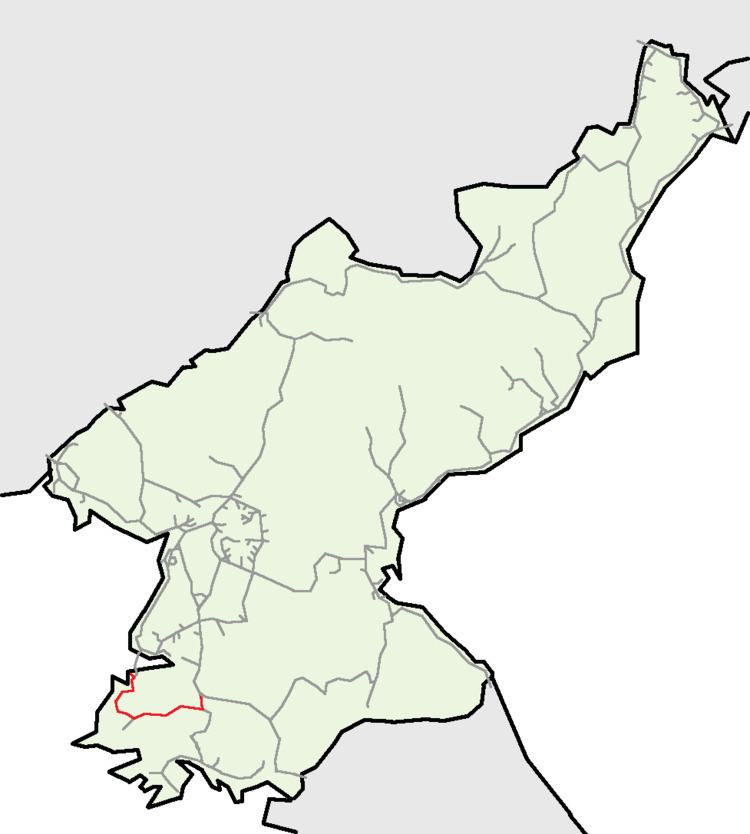Native name 은률선(殷栗線) Termini Ŭnp'aCh'ŏlgwang | Status Operational Stations 18 No. of tracks Single-track railway | |
 | ||
Type Heavy rail, Passenger/FreightRegional rail Locale North HwanghaeSouth Hwanghae | ||
The Ŭnnyul Line is a non-electrified standard-gauge secondary line of the Korean State Railway in the North and South Hwanghae provinces of North Korea, running from Ŭnp'a to Ch'ŏlgwang. It is an important line in economic terms, connecting the agricultural and ore-producing areas of Kwail and Ŭnnyul counties with the rest of the DPRK.
Contents
The line connects to the Hwanghae Ch'ŏngnyŏn Line at Ŭnp'a, to the Changyŏn Line at Sugyo, and to the Sŏhae Kammun Line line at Ch'ŏlgwang, and formerly connected to the narrow gauge Ryongjŏng branch at Ch'ŏlgwang. The ruling grade is 15‰, the minimum curve radius is 300 m; there are 67 bridges with a total length of 2,515 m (8,251 ft), but only two tunnels with a total length of 200 m (660 ft).
History
The West Chosen Development Railway (西鮮殖産鉄道, Seisen Shokusan Tetsudō; 서선식산철도 Seoseon Sigsan Cheoldo) was formed in 1920 to take over the 762 mm (30.0 in) narrow gauge Sanghae—Hwasan—Naet'o line built by the Mitsubishi Ironworks as a company-use railway, and then built a new narrow gauge line from Sariwŏn to Chaeryŏng via Sanghae. This new line was opened on 21 December 1920, and on 16 November of the following year it was extended from Chaeryŏng to Sinch'ŏn.
On 1 April 1923, the West Chosen Development Railway and five other railway companies merged to create the Chosen Railway (abbreviated Chōtetsu), which took over all lines and operations of its predecessors. Chōtetsu grouped the Sariwŏn—Sanghae—Sinch'ŏn and Sanghae—Hwasan—Naet'o lines inherited from the West Chosen Development Railway together, calling them the Hwanghae Line, and subsequently expanded the Hwanghae Line network significantly. These expansions included the extension of the Sariwŏn—Sinch'ŏn line, opening a section from Sinch'ŏn to Sugyo on 1 November 1929, followed by a section from Sugyo to Changyŏn on 21 January 1937.
Chōtetsu sold the Hwanghae Line network to the state-owned Chosen Government Railway (abbreviated Sentetsu) on 1 April 1944, which absorbed the Hwanghae Line network and split it up, calling the Sariwŏn—Sinch'ŏn—Changyŏn line the Changyŏn Line. Although Sentetsu did make significant expansions to other parts of the former Hwanghae Line network, this line remained unchanged for the duration of Japanese rule in Korea.
After the end of Japanese rule and the subsequent partition of Korea, Sentetsu's Changyŏn Line was located in the northern half, becoming part of the Korean State Railway. After the end of the Korean War the Railway Ministry of the DPRK began to expand and improve its network, including in South Hwanghae, leading to the opening of a line from Sugyo to Ch'ŏlgwang in 1963. With the opening of the new line, the Sariwŏn—Sugyo—Ch'ŏlgwang line was named Ŭnnyul Line, leaving the Changyŏn Line as just the short branch from Sugyo to Changyŏn. A branch to serve ore mines around Sŏhaeri and the port at Ryongjŏng was opened in 1964, but has been out of use since 2002. In 1971, a new standard gauge line was opened from Ŭnp'a on the former Sahae Line to Chaeryŏng, and at the same time, the Chaeryŏng—Sinch'ŏn—Sugyo section was converted to standard gauge. The opening of the new standard gauge line from Ŭnp'a to Chaeryŏng led to the closure of the narrow gauge Sariwŏn—Chaeryŏng line. The regauging of the rest of the line from Sugyo to Ch'ŏlgwang was completed in 1973.
Services
In terms of traffic quantity, freight on the Ŭnp'a–Sugyo section is roughly the same in both directions, but the bulk of freight on the Sugyo–Ch'ŏlgwang section is iron ore eastbound from the Ch'ŏlgwang area destined for the Hwanghae Iron & Steel Complex on the Songrim Line. Fruit from Kwail and Hwanghae Ryongmun is also a significant source of freight originating on the line. The primary commodities arriving onto the line from elsewhere include anthracite, fertiliser, wood and cement.
The following passenger trains are known to operate on this line:
Main Line
A yellow background in the "Distance" box indicates that section of the line is not electrified; a pink background indicates that section is 2 ft 6 in (762 mm) narrow gauge; an orange background indicates that section is non-electrified narrow gauge.
Ryongjŏng Branch
The Ryongjŏng Branch, also known as the Sŏhaeri Line, is a ten-kilometre long, non-electrified 762 mm (2 ft 6 in) gauge line opened in 1964. At its peak the line carried 6,000 tonnes of ore daily. Besides the frequent trains to stations, there were 12 daily round trips to the port, each train consisting of 21 self-unloading hoppers. The line has been out of use since 2002.
